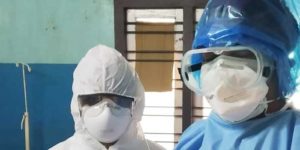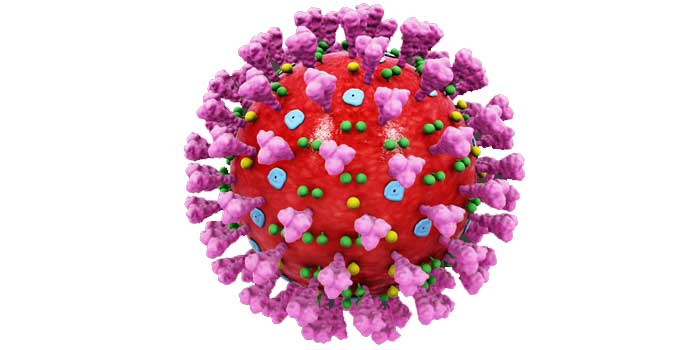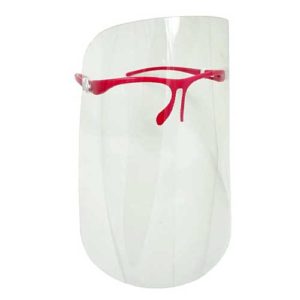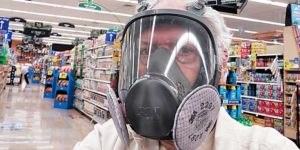To Wear or Not to Wear Eye Protection – That is the Question
It was March 2020 when the USA SARS-CoV-2 epidemic was just getting underway. Dr. Fauci, spokesman for the pandemic response team of the U.S. government, downplayed the need for masks saying, “There is no reason to be walking around with a mask.”
Not long afterwards, he changed his statement and said masks were recommended. His explanation for this message change was that the government feared a mask shortage and did not want medical personnel to not have masks available due to the public acquiring all of them and creating a worse shortage than all ready existed.
Might I need eye protection against covid-19 in this pandemic? So far, we have not seen recommendations about eye protection forthcoming from the CDC, NIH or the federal government. This article is strictly my own opinion as a retired ophthalmologist and not medical advice for anyone.
Do They Know Something We Don 't?

When we see pictures of front-line, medical workers, in their fight against covid-19, one thing we notice is that most, if not all of them, have some sort of eye protection. This might be a plastic face shield. It might be goggles. It might be shielded glasses. So what does this mean for the rest of us? I submit that it is a good indication, that for more complete protection, you and I should be using eye protection against covid-19 as well.
Invasion of the Virus
There is universal agreement that covid-19 is spread mainly by inhaling the virus which has been exhaled by an infected person. Other conceivable methods of spread are hand-to-mouth, hand-to-nose, hand-to-eye, sexual contact and air-to-eyes. That last possibility is what we are discussing here.
We all know that the corona virus is transmitted by way of our mouths and noses, right? This is true as far as it goes. How about our other exposed mucus membrane; namely, our eyes? That’s right; our eyes are covered with a very thin membrane we call the conjunctiva. One could think of it as a thin, wet “Saran Wrap” sort of membrane covering the eye surface.
The coronavirus invades cells within the respiratory tract (lungs). It gains entry to these cells by attaching itself to a protein on the outside of the cell called angiotensin converting enzyme 2 or ACE2. Think of this like a home invader who has a key that fits the lock to your front door. The spikes on the coronavirus are the keys and the ACE2 protein is the lock on the door.
Can Virus Get in My Eye?
Recent studies showed that this ACE2 is present in the human conjunctiva and on the cornea. In theory, the virus could use the eye surface to get an initial foothold for entry into the human body.
Another study even found the virus present in the actual eye tissue of a previously infected covid-19 patient who had undergone glaucoma surgery.
Does this mean we should have eye protection against covid-19? Let’s look some more.
Down the Tear Hole
One of the properties of the eye’s anatomy is that in the inner corner of each eyelid is a tiny hole called the lacrimal punctum. This hole is where the tears, that we produce, drain. From each of the four puncta there is a tube eventually leading to the inner area of the nose. From the back of the nose the tears go to the throat. Anyone who has ever used eye drops can remember getting a delayed, funny taste in their mouth as the chemical in the drop stimulates the taste buds after draining into the back of the throat. These virus-containing tears are exposed to the air that we breathe in, giving potential entry into our lungs.
One of the more recent findings about covid-19 is that it can be spread as an aerosol. This is not the same as droplets. Droplet borne is the property of the virus being transported, balloon-like, in droplets that humans exhale during sneezing, coughing, breathing, talking and singing. These droplets usually fall to the ground within six feet or so from their origin, due to gravity.
Aerosol borne means that the virus particles can be suspended in the air for long periods of time and travel much farther than the six feet of “social distancing” we are told about. This would be analogous to smoke particles in a smoky room. An aerosol particle is small (1 to 5 μm) (microns). For reference, a microscopic human red blood cell is 7 microns in diameter.
Aerosols have the property of remaining suspended in the air instead of falling to the ground, something like smoke or dust particles that can be seen in the projector light in a dark theater. Aerosolized coronavirus particles can be inhaled but they can also land directly on the eye surface. In theory, the virus particles could then be washed down the lacrimal puncta and then into the throat and even the respiratory system.
So, Do Glasses Help?
To date, we do not have studies showing that there is a significant risk of catching covid-19 from eye exposure. There are studies showing that there is a lower incidence when eye protection is worn, just as there is a lower incidence from wearing a mask and practicing social distancing. A recent medical journal article from China suggested that people who wore glasses were less likely to get covid-19 than those without.
This could be because the glasses prevented touching of the eyes or the virus was less likely to land on the eyes from the air. In the Chinese study a small number of records of inpatients with covid-19 was examined. From more than 200 patients, just over 5% wore glasses for nearsightedness. In the general population about 30% wear glasses for myopia. The implication is that maybe glasses offer a protective effect from getting covid-19.
Compared to the amount of air we inhale and exhale, the amount of air making passive contact with our eye surface is much less. However, studies have shown that most people touch their hands to their faces and eyes many times during the day. If one is wearing glasses, goggles, face shields or other eye protection gear, he is much less likely to be touching his eyes. Whether preventing touching of the eyes, or direct landing of air borne virus on the eye, the implication is that eye protection against covid-19 may help.
Virus Load
One of the characteristics of viral infection is the concept of dose dependency. This means that if one virus particle lands on one lung cell, probably the body will have enough immunity to kill it and remain unaffected. If a billion virus particles land on a lot of lung cells in a vulnerable individual, the viruses will possibly overwhelm the immune system and the person will become a covid-19 victim. If a trillion virus particles end up in the lungs it might lead to an overwhelming covid-19 infection and even cause loss of life.
These values are conceptual and not based on scientific study data. The quantity of virus needed to create significant sickness varies with the health and immune status of the person infected. We know that young people with strong immune systems are less likely to become significantly ill than elderly people with weak immune systems.
Types of Eye Protection against Covid-19 V irus

Goggles – The cheapest and easiest might be simple protective goggles such as are worn when we hammer a nail or work around dangerous equipment. These may be used alone or over prescription glasses. When used with a face mask these offer good eye protection against covid-19.

Eyeglasses – Ordinary eyeglasses, either prescription or non-prescription, would be another choice but would not offer as much eye protection against covid-19 as a full goggle would.
Face Shield – A face shield offers a barrier for the whole face and eyes. It reduces the chance of bringing one’s hands to his face and eyes but, of course, leaves some exposure around the edges below and on the sides. When worn with a face mask this offers good eye protection against covid-19.
Full Face Respirator – A full face respirator mask, “gas mask”, serves to protect the whole face, nose, mouth and eyes. It is expensive and makes conversation difficult to understand. These have filters to keep out substances such as dust, gas, and even viruses (using N95 filters). Their valves allow exhalation. This probably represents the best eye protection against covid-19 of the choices shown.
My Personal Choice
Early in 2020, when I first heard that the pandemic was starting in China, I ordered a 3M full face mask in case a worst case scenario should develop in the USA. Unfortunately it has. Now, I routinely wear this complete mask whenever it is necessary to go to public places like the grocery store or the pharmacy.
So, What's the Answer?

Right now, there is no conclusive data to show that the general public should be wearing eye protection in addition to face masks. However, there are hints that maybe we should be wearing eye protection. If you’ve ever watched a movie (think “Contagion”) where the hazmat team comes to the rescue, they are always covered from head to toe to avoid any possibility of virus spreading not only by inhalation but also by landing on some part of the body including the eyes.
Like most things in life whether to wear eye protection against covid-19, during the pandemic, comes down to “risk-reward”. How likely are you to get infected through your eyes if you don’t wear eye protection? We do not know. How much bother is it to wear eye protection? It varies with the person. There are people who would not wear a seat belt when driving if it were not mandated. There are still people not wearing a mask even when it is mandated. I submit that if one wants to be as safe as possible then, in addition to a face mask, social distancing, crowd avoidance and hand washing, we should add wearing some sort of eye protection. It cannot hurt.






Excellent article, where can we order our 3M face masks?
Click on link. It takes one to the mask. Thanks.
Wow! Love how you think and explain things. Also like to hear your friend Steve.
I found the link to the article from China interesting, perhaps you can include their findings in more detail in this article. Thank you for sharing Dr Edwards.
Thanks for the suggestion. It has been done.
Interesting article! Very helpful information.